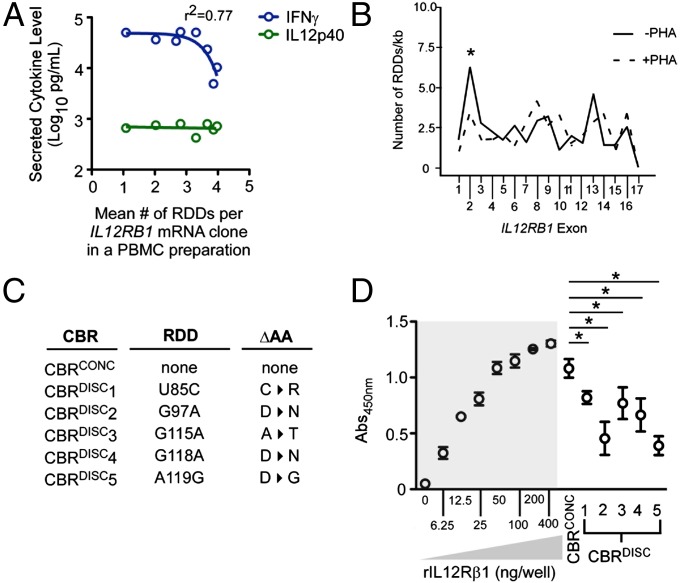Fig. 4.
IL12RB1 RDDs concentrate in the IL12Rβ1 CBR and negatively affect IL12p40-binding. (A) The relationship between the mean IL12RB1 RDD frequency in a given PBMC preparation (i.e., the average number of RDDs per IL12RB1 mRNA clone in PBMCs of a given donor) and the amounts of IL12p40 (green) and IFNγ (blue) secreted by the same PBMC preparation. A nonlinear regression analysis is shown for IFNγ. (B) The RDD rate for each exon was calculated by dividing the number of RDDs that occurred in that exon by the exon length. The mean RDD rate for each exon (RDD/kb); data are combined from nine donors. The significance of an exon enrichment was determined by comparing each individual exon RDD rate with the mean rate of all exons combined (fixed effects analysis); a significant departure from the mean rate is indicated by an asterisk (P ≤ 0.05). (C) The RDDs and associated amino acid changes present in each IL12RB1 mRNA clone selected. Five clones contained RDDs in exon 2 that changed the protein sequence by one amino acid (U85C, C→R; G97A, D→N; G115A, A→T; G118A, D→N; A119G, D→G), and thus produced CBRs that were discordant with the gDNA sequence (CBRDISC). One clone contained no RDDs, and was thus used to produce a CBR concordant with that of the IL12RB1 genome sequence (CBRCONC). (D) Recombinant CBRs were used to assess IL12p40 binding via ELISA; full-length recombinant IL12Rβ1 (rIL12Rβ1) was used as a positive control with which to compare the binding ability of CBRCONC and CBRDISC. Shown are the binding capacities (Abs450nm) of each preparation when bound to wells coated with a saturating amount of IL12p40. rIL12Rβ1 was added to IL12p40-coated wells at varying amounts (0, 6.25, 12.5, 25, 50, 100, 200, and 400 ng/well) to determine what amount confers maximal IL12p40 binding; given the results of this determination (highlighted gray), all recombinant IL12RB1 CBRs (CBRCONC and CBRDISC1–5) were added to IL12p40-coated wells at 200 ng/well. Significant differences (P ≤ 0.05) between CBR preparations’ abilities to bind IL12p40 were determined by ANOVA analysis.

